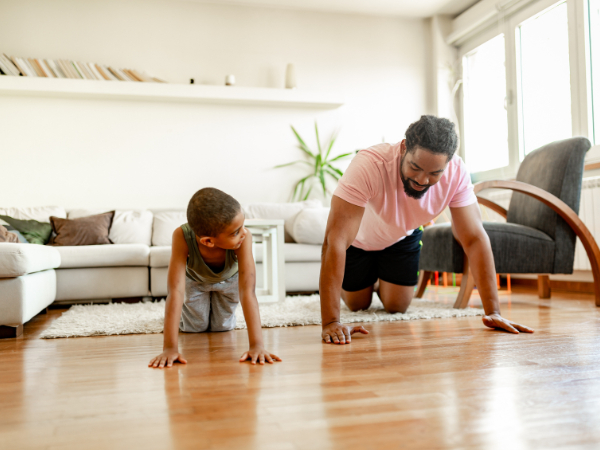At-Home Exercise Guide for Arthritis
Physical activity plays an important role in managing arthritis – especially when it comes to reducing pain and improving mobility. Yet, many people living with different types of this disease do not meet recommended physical activity levels.
In fact, 50 per cent of people in Canada are not physically active during their free time, and the rate is even lower in people with arthritis.
Pain, fatigue, or being unsure about how to exercise safely can lead to a sedentary lifestyle. So we’ve put together a quick guide to help people exercise safely and effectively from home this summer. Common areas associated with Arthritis exercise include knee, hand and hip exercise.
Tips from an Exercise Professional
Jasmin Ma is a kinesiologist and clinician investigator at Arthritis Research Canada with an expertise in physical activity interventions for individuals with chronic disease and disability, as well as strength training behaviour change. Here are some of her top tips on getting started, equipment, strength training and more:

Getting Started
- Always remember that exercise, when done correctly, is safe for people with arthritis (and other long-term conditions)! In fact, exercise can help with pain and symptom management. Feeling unsure, click here to learn more.
- Start at the level you’re comfortable with (whatever that is) and make small changes that add challenge to your routine over time. Being physically active is a lifestyle. These changes don’t happen overnight. To learn more about how to get started, click here.
- Be flexible: You can use your warm up (movements that get your heart rate up a bit, bringing your joints through safe range of motion, practicing the movements of your main workout at a lower intensity) to determine how you feel each day. When you’re in a flare or aren’t feeling as well, move at a lighter intensity and focus on areas of the body that feel the best.
- While doing planned and structured exercises (e.g., a home workout or routine at the gym) is important and beneficial, being active comes in many shapes and forms: Playing with your kids, walking/wheeling to work, carrying groceries home, playing sports, gardening, etc. The key is to find what MOVES you.
- Work with a team to explore what being physically active might look like for you. This includes but is not limited to your doctor, physiotherapist, occupational therapist, kinesiologist, friends and family, and many others!
Home Exercise Equipment

Cardio exercises: continuous, repetitive movements that raise your heart rate
- On days when you’re feeling good, aim to work to the point where you could talk, but not sing a song, while you’re exercising.
- No equipment! Moving your own body!
- Dancing or Zumba, Tai Chi, taking the stairs, walking/wheeling, boxing, and martial arts are all great ways to get your heart pumping.
- Wooden dowel or broomstick
- Rowing, pushing above your head, in and out, in circles
- Click here for an example
- Portable arm or leg bikes
- These can fit on or under your desk and are good fun for trying interval training! Think working hard for a short period of time, taking a short rest, and repeating. E.g., 20-30 seconds at a fast pace, 30 seconds at a slow pace, repeat 5-8 times.

Muscle Strengthening Exercises: Movements Against Resistance that Help to Improve your Strength and Function.
Resistance can include your own body weight, resistance bands, dumbbells, kettle bells, medicine balls, exercise machines, or even household items!
- Have difficulty with grip? Try the following tips:
- Use wrist or cuff weights
- Tie a loop at the end of your resistance band that you can slide your hand through and hold the resistance at the wrist.
- Tie a wrist sweat band to the end of your resistance band to hold the resistance band at your wrist.
- Do I have to purchase fancy equipment?
- No, you can use:
- cans
- water bottles
- milk jugs
- containers with handles
- books
- basically anything from Costco
- Resistance bands are relatively inexpensive, but even pantyhose, tights, or other stretchy materials work!
- No, you can use:
- “I want to lift heavier weights, cans just aren’t going to cut it.”
- Get creative!
- Fill a backpack, shopping bag, or duffle bag with heavy items like books or a bag of rice.
- Use a wooden dowel or broomstick and hang filled reusable bags to simulate a barbell for e.g., a deadlift.
- Hiking a hilly or mountain trail is a great way to improve leg strength.
- Explore the beach/forest: Logs/driftwood found outdoors can be used for a landmine or overhead press.
- Playground equipment can be used for pull-ups (Woody bands can be used if pulling up your full body weight is too much).
- Know that you don’t have to lift heavy to be strong or get bigger muscles. You can lift lighter weights for more repetitions and get the same benefits, so long as you lift to or near momentary muscle fatigue (where you can’t complete another full repetition with good form).
- Get creative!
Tips from Someone Living with Arthritis
Trish Silvester-Lee is a member of Arthritis Research Canada’s Arthritis Patient Advisory Board. She has lived with osteoarthritis for over 30 years. Trish was very active prior to developing this disease. She has since had a total knee replacement, but remains committed to her exercise routine. Trish says trial and error is key to finding what works. Her routine also changes over time, along with her osteoarthritis.
Exercise to Prevent Falls
- Stability exercises:
- Foam stability rings, balance balls and boards, as well as trainer pads are great to help with balance.
Post-Surgery Tips
- Move it or lose it! You can still remain active after surgery. Try an exercise bike to help maintain your range of motion. Worried about sore joints? Use a recumbent bike, which can be easier on the knees.
- Always make sure to check with your surgeon/healthcare provider before starting a new exercise routine following joint replacement surgery.
Adapt Exercises
- If it’s hard for you to get down on the floor and back up again to use equipment like an exercise ball, try using it in bed instead!
- Lay on your back with your knees at 90 degrees, put the ball under your knees and move your heels in and out, bringing your knees to your chest to work your range of motion.
- Don’t let a flare hold you back. For example, if you regularly use exercise bands at home, make sure to keep an assortment in different colours and tensions. That way, when you’re experiencing a flare, you can use lighter weight bands. When you aren’t in a flare, increase the tension.
- Don’t just adapt your exercise routine. Raise your sofa, bed and chairs with blocks to make it easier to get up and down. This can prevent knees from getting agitated and interfering with your exercise routine. Blocks can be found at home healthcare stores.
It’s Not Just About Equipment
- There are many ways to stay fit if you don’t have space or a budget for equipment.
- Try deep water running at your local community centre.
- Go for a walk around the block.
- Do squats, lunges, push ups, etc.
Resources
- Arthritis self-management classes can be great places to get exercise ideas from healthcare professionals, as well as other people living with different types of arthritis (especially through Q&A sessions). Sharing information with others living with arthritis can be very helpful.
- Physiotherapy associations like the Physiotherapy Association of British Columbia offer excellent resources.
- Consult a physiotherapist for exercise guidance – especially after an injury.
When it comes to exercising with arthritis, there are many options. Just make sure to check with your physician or medical team before changing your fitness routine. And remember, exercise is medicine. Try to develop a fitness routine this summer and see how it helps with managing arthritis pain, fatigue and more.




















































